The answer is not another pill. The answer is spinach. -Bill Maher
Spinach is popularly listed as a “superfood,” and is commonly cited as the healthiest, easiest-to-eat food for human beings, and can be eaten in a dizzying amount of different ways. However, spinach does contain a lesser-known health risk, that certain people need to be aware of, and we’ll break this down below. This article lays out the full story about the health benefits of spinach. Why is spinach supposed to be so great for us? What is a potential risk in overeating on spinach?
- 33 Distinct and Unique Health Benefits of Spinach
- Tips and Tricks for Making Spinach Salads
- 5 Outstanding Recipes for Spinach
- Why spinach is the easiest, healthiest food out there
- The one actual health risk in eating spinach
Even in my own experience, spinach is a must when I’m at the grocery store. It lasts a long time in the fridge, but nothing compares to how adaptable spinach is. Spinach has a home in food from cultures all over the world, from Italian food, to Mexican or Caribbean food, to, Thai, Indonesian, Indian, African, and Greek food, and much, much more. No matter what I’m cooking for friends or family, spinach is my favorite way to add a luscious soft flavor and satisfying “oomph” to my meal without overpowering the other tastes. Even though spinach is an age-old favorite, dating back to Popeye and his predecessors, science has recently discovered even more reasons to eat more of this outstandingly nutritious superfood.
WHAT IS SPINACH?
Native to central and western Asia, spinach was first introduced to the ancient Chinese as “Persian vegetable,” and is a healthy, flavorful leafy green that goes well in salads, and makes a great addition to just about any savory dish. Spinach has almost zero fat or cholesterol, and is an excellent source of zinc and niacin, as well as fiber, protein, and a number of key vitamins and minerals. Spinach has a light, bittersweet taste that is not overpowering.
WHAT IS SPINACH GOOD FOR?
Also called “Spanish vegetable” by the English through the middle ages, spinach is good for a wide variety of applications in the kitchen. Spinach is also chock-full of flavonoids, a powerful antioxidant shown to possess properties such as being anti-allergic, anti-inflammatory, anti-microbial, anti-viral, anti-cancer, and even anti-asthma.. Spinach is healthy, no question, but what is spinach good for it in the kitchen, and how can we work with it? Spinach is great in purées for sauces, and is a key ingredient in dips, quiches, soups, salads, sandwiches, curries, smoothies, pizzas, and even Spanakopita, the delicious and semi-famous Greek spinach pie.
NUTRITIONAL VALUE OF SPINACH
Spinach is a time-tested classic for seekers of healthy food, with new benefits being discovered all the time. Here are some great key factors demonstrating the nutritional value of spinach.
FRESH SPINACH NUTRITION
The nutritional benefits of fresh spinach are many. It used to be popular to cook spinach, and this can leach out vital nutrients. Keeping your spinach raw and uncooked has great benefits for health. Raw spinach has the advantage over cooked spinach in that it is higher in:
- vitamin C
- folate
- niacin
- riboflavin
- potassium
Nutrition FactsServing Size: (100.00 grams). |
||
Amount Per Serving |
Serving Size |
|
| vitamin C | 47% | 100 gm |
| Folate | 48.5% | 100 gm |
| Niacin | 4.5% | 100 gm |
| Riboflavin | 14.5% | 100 gm |
| Potassium | 12% | 100 gm |
| *Daily value not established. | ||
These key vitamins and minerals are a big part of why spinach is one of the healthiest things in the world you could hope to eat.
BABY SPINACH NUTRITION
Spinach harvested between 15-35 days after planting is commonly called “baby spinach,” and this type of spinach can have some interesting health benefits over regular spinach, which is typically harvested between 40-65 days after planting. Some research has shown that baby spinach has higher levels of vitamin C, carotenoids, and antioxidants like flavonoids, as well as lower levels of oxalic acid. However, other research has refuted this, and it seems most of the data depends on the soil and growing conditions of the spinach. The best approach to baby spinach is to use it raw in quick salads, while perhaps leaving the larger-leafed more mature cousins for cooking.
SPINACH LEAVES NUTRITION
There are myriad benefits of mature spinach leaves. Less delicate, heartier and easier to preserve, mature spinach leaves are the traditional classic. Here are some vital specific health benefits of eating spinach:
- spinach is shown to improve circulation and bone health, via vitamin K DRI
- spinach helps prevent asthma attack
- preventing dementia
- reduces risk of macular degeneration and cataracts
- nitrates in spinach boost protein production, aiding muscle growth
It looks like Popeye’s logic wasn’t wrong – and further, everyday spinach has incredible health effects beyond what you might have thought.
WHAT VITAMINS IN SPINACH?
One great question is about the vitamins that can be found in spinach. There are a ton of vitamins in spinach, and here is a list of some of its top vitamins [source]:
Nutrition FactsServing Size: 1.00 cup(180.00 grams). |
||
Amount Per Serving |
Serving Size |
|
| Vitamin K | 987% | 180 gm |
| Vitamin A | 105% | 180 gm |
| Vitamin B1 | 14% | 180 gm |
| Vitamin B2 | 32% | 180 gm |
| Vitamin B6 | 26% | 180 gm |
| Vitamin B6 | 17% | 180 gm |
| Vitamin E | 25% | 180 gm |
| Vitamin C | 24% | 180 gm |
| Calcium | 24% | 180 gm |
| Potassium | 24% | 180 gm |
| Zinc | 12% | 180gm |
| Phosphorus | 14% | 180 gm |
| Choline | 8% | 180 gm |
| Protein | 11% | 180 gm |
| *Daily value not established. | ||
As we can see, spinach doesn’t short-sell anyone when it comes to nutrition.
SPINACH CALORIES
If you’re concerned about calories, you’re going to love spinach. One cup of spinach has about as many calories as three Tic-Tacs, or about 7 calories. This is a huge benefit of spinach, because if you’re watching your weight, spinach is not going to hurt you. The average American eats about 2.5 pounds of spinach per year, which is about 50 cups of spinach. This is literally 350 calories per year. 350 calories is less than one meal for most people, so literally spinach barely pings the radar when it comes to calories. Literally, as the math above shows, we eat fewer calories from spinach in a year than we do from one typical meal. Especially once we consider that the body does burn calories to digest food, there’s no doubt that spinach has a microscopic calorie count.
33 SPINACH HEALTH BENEFITS
The health benefits of spinach are without doubt. But to really fully flesh out the reasons “pro” for eating spinach, here are 33 highlights: 1.) Heart health – Spinach has some heartwarming benefits for cardiac health, which directly increase longevity, and time with our loved ones. Spinach has been shown to be high in omega-3 fatty acids, which are excellent for cardiac health. [source] Additionally, the rich folate content of spinach causes a decrease in homocysteine levels, which directly reduces the risk of heart disease. Heart disease remains the number one biggest killer of Americans every year, so this is a huge deal, that spinach reduces the risk of cardiovascular disease. I’m sure we all know someone or another who has passed away due to this sad, all-too-common illness. 2.) Acne Prevention – One of the best, most surprising or eyebrow-raising spinach health benefits is in helping prevent acne. The alkaline properties of spinach, including its rich chlorophyll content, all contribute to fighting the bacteria that cause acne. Spinach is also rich in vitamin A, which has been shown to help skin in all kinds of ways, including preventing dead skin cells from clogging pores, reducing how oily our skin can get, and helping overall health in general. 3.) Heartburn – Spinach is famous for helping prevent acid reflux. Getting heartburn more than two times a week is indicative of suffering from acid reflux disease, and of course, spinach can help you with that. More formally referred to as gastroesophageal reflux disease, or GERD, spinach is a great pillar of health for people suffering from GERD. Experts in this disease recommend not pairing spinach with creamy substances, or frying it. More baby spinach, eaten raw, or lightly cooked without high-fat additives is the prognosis for smoother digestion and increased personal control over one’s own GERD. 4.) Constipation – Since spinach is so high in fiber, it is a favorite for helping with regularity. If you or a friend is suffering from constipation on a consistent basis, spinach could be the key. It can be fairly said that spinach is the most vital food for digestion since the dawn of time. “Raw spinach holds the finest organic material for the cleansing, reconstruction, and regeneration of the intestinal tract. Raw spinach juice-100 ml, mixed with an identical quantity of water and taken twice daily, will cure the most aggravated cases of constipation in a few days.” 5.) Hair growth – One more surprising health benefit of spinach is that it aids hair growth. You might not believe it, but spinach is shown to do a number of great things for hair growth. The high protein, vitamin A, and vitamin C content of spinach allow the body to properly regulate oil on the scalp, keeping hair from becoming brittle, and helping prevent hair loss. These factors also help hair to grow more quickly. This is a big deal for people with histories of hair loss in their family. To get this going for yourself, one great recipe is to take one cup of spinach leaves, mix it with one tablespoon of honey, olive oil, coconut oil, or castor oil, blend it, making sure it has the right consistency, and then applying the mixture to your scalp, keeping it in place for thirty to sixty minutes. [source] So overall, this type of approach is a very frugal way to arrive at repaired, shiny, silky hair. 6.) Sleep – Due to its high vitamin counts, spinach is great for helping us sleep healthily. Spinach is, of course, high in vitamin B6, and in magnesium. B6 helps us produce serotonin, which is the hormone that calms us and helps regulate our sleep and wake cycles. Magnesium is also great for Restless Leg Syndrome, commonly known as RLS; as well as helping a great many other aspects of sleep health. The high calcium content of spinach also helps the body better regulate melatonin, the hormone that helps us maintain our circadian rhythms. So whether you cook it, leave it raw, or however you eat your spinach, it’s going to help you sleep better, no question. 7.) Weight Loss – Almost a no-brainer, with 7 calories per cup, spinach is a great way to fill up on healthy food without risking weight gain. There are some very compelling spinach benefits for weight loss, and if you’re trying to cut pounds and shed fat, spinach is your best friend. Spinach is the perfect way to change the habit of hedonistic hunger, which is a craving for unhealthy food that harms our long-term health. This happens mainly out of habit because we most frequently crave what we’ve most recently eaten, whatever we just ate. Spinach is perfect for changing our hunger patterns to what’s called homeostatic hunger, which is a more real hunger for the raw vitamins and nutrients the body needs. 8.) Anti-cancer – Spinach has been shown time and time again to have anti-cancer and anti-inflammatory antioxidants. There is a mountain of research showing how spinach helps fight cancer, and to help start unpacking this, it really starts with how spinach has to do with protecting our DNA during replication. The high folates in spinach protect our genetic blueprints from changing during cell division, a risk that can lead to cancer, and early-onset forms of aging in other ways. It’s definitely no longer out-of-the-ordinary to tout the anticancer benefits of spinach, and you will find spinach advocates for people at risk of cancer all the way to the highest levels of research. 9.) Body Alkalizer – Most of us have an acidic diet, between the coffee, tea, and other food we eat, this can be a problem that the alkaline properties of spinach counteract. Body acidity can lead to imbalances in gut bacterial levels and makes us more at risk of yeast growing out of control. A high level of body acidity can also mean more risk of acne, and scarring pimples. By reversing this acidification of the body, spinach protects us against these potential problems. 10.) Bone Health – Filled with vitamin K, spinach protects bones from common risks. Spinach is known for helping bones absorb the minerals they need to be strong; this process is referred to as bone mineralization. This also helps delay or prevent the onset of osteoporosis. Spinach helps with the bones’ ability to absorb minerals. It’s vital to keep in mind that spinach has high oxalate content, which can also work to block calcium intake, so if this is a concern for you be sure to at least lightly cook your spinach before serving it. 11.) Eye health – With its copious carotenoids, spinach is excellent for eye health. Spinach protects against cataracts, and macular degeneration, which are risks for our eyes we all face as we get older. There are also high levels of eye-benefitting lutein and zeaxanthin, which “do wonders for your eyes.” Overall, with its super-food status, it’s no surprise that spinach is a key part of keeping eyes healthy for the long term. 12.) Prevents anemia – High in iron, spinach is a great vegetarian way to prevent iron deficiency. Anemia is commonly experienced by vegetarians or people who eat a reduced-meat diet. Spinach is key support in any diet involving reduced meat. The iron in spinach is what keeps you safe from the risks of anemia, but more specifically, because spinach is also high in calcium, vitamins A, B9, E, and C, as well as fiber, iron, and beta carotene, spinach has been reported to be the number one, hands-down, absolute best food to combat anemia. 13.) Preventing the effects of aging – Spinach benefits include preventing the signs of aging with its high amount of antioxidants, which prevent cancer-causing free radicals. These free radicals are highly reactive substances in the body that can spontaneously damage cells at any time, including their DNA, which can immediately create cancer, and also causes other signs of aging, like skin degeneration. All of this, spinach helps prevent, because it is high in lutein, beta-carotene, and zeaxanthin, reinforcing that spinach is a true superfood. 14.) Muscle strength – Spinach is a classic for strength gain without risking weight gain. According to experts all over the world, spinach really does help build strong, lean muscle. It goes counter to a lot of the protein-shake culture that exists around the country, but copious amounts of spinach are a great way to pack on muscle and not worry about adding junk to your body. No doubt, you have to eat a lot of spinach to get the results most people are used to, closer to a pound or two a day, but it’s possible, and that’s fascinating. 15.) High Blood Pressure – If you suffer from hypertension and have been hesitating to jump on eating more spinach, high blood pressure has actually been shown to go down as a result of increasing spinach consumption. Due to spinach’s high amounts of potassium, folate, and magnesium, spinach can do miracles for blood pressure. So many people out there suffer from this one, and it’s easy to let the coffee and little treats and desserts of life catch up, and suddenly our blood pressure is too high. Spinach is the medicine for that common malady, demonstrated to lower blood pressure and help mitigate the risks of hypertension. 16.) Prevents ulcers – By protecting the stomach’s mucous membrane, spinach helps prevent ulcers. Ulcers are common problems resulting from a poor diet, smoking, or some combination of the two. By eating more spinach, like, a lot more, you may be able to calm down and away the foods in your diet that have been causing the acidification of your stomach. Spinach is actually basic, or alkaline, so it counteracts the acid in the stomach and helps calm it down, just like a capsule of Tums, or a glass of milk, but spinach is the most gentle on a sick stomach of all those above options. 17.) Fetal Nerve Growth – Spinach is great for expectant families looking to do everything they can for their child’s health. Spinach and it’s high folate content have been shown to help reduce the risks of cleft palates forming, or spinabifda, both of which are said to occur due to reduced folate availability in utero. Vitamin A, which is found in abundance in spinach, is also great for fetal lung development. There are a ton of ways spinach helps a growing fetus, and it’s advised for pregnant moms everywhere to get their spinach. 18.) Diabetes Management – Spinach’s alpha-lipolic acid helps lower blood glucose levels. Additionally, the high fiber content in spinach keeps the body regular, and helps anchor blood sugar levels. Since diabetes is a chronic illness of the pancreas, that means the body can’t regulate blood sugar levels well enough. Spinach is a gentle, healthy, and safe way to help the body pull its blood sugar up from the dangerous depths, or calm things down if there’s too much. Spinach acts as an anchor and is very helpful for people who have diabetes. 19.) Asthma Prevention – The beta-carotene in spinach is shown to helping lower the risks of an asthma attack. A 68,000 subject study actually found that women with increased intake of spinach correlated directly to a lowered risk of asthma. That’s a big deal for asthma sufferers out there, because nothing is as scary or difficult as suddenly not being able to breathe. Spinach’s high amounts of vitamin C, beta-carotene, vitamin E, and magnesium all contribute to its anti-asthma properties. 20.) Healthy skin – Spinach’s high quantities of vitamin A help skin to stay moisturized. Further, the high vitamin C content in spinach helps keep our skin’s oil content properly moderated. The vitamin A content of spinach helps with sebum production, and that makes for incredible, shiny hair that can’t be faked. 21.) Preventing Prostate Cancer – Spinach helps stop prostate cancer and prevents cancer from spreading. About one in 39 men will die of prostate cancer, and one in seven will receive a diagnosis of prostate cancer in their lifetime. Prostate cancer occurs just about as often in men as breast cancer does in women, and spinach is great at fighting the onset and relapse of all of these types of cancer. Further, “In a recent study on the relationship between risk of prostate cancer and vegetable intake — including the vegetables spinach, broccoli, cauliflower, cabbage, Brussels sprouts, mustard greens, turnip greens, collards, and kale — only spinach showed evidence of significant protection against the occurrence of aggressive prostate cancer.” [source] 22.) Infant Health – Spinach is a great source of gentle proteins for new babies. Spinach is very popular as baby food, since it’s so soft and good for digestion. The high calcium content in spinach also helps for bone growth and bone mineralization, meaning that your youngster will have stronger bones growing up and fewer breaks. It’s generally recommended to introduce your baby to spinach around the ages of 6-7 months on the early side, or 10-12 months on the more conservative side, whatever you’re most comfortable with. 23.) Blood health – Spinach is shown to help red blood cell health. A cup of cooked spinach has 6.4 milligrams of iron, which is a real whallop. This helps combat anemia. Spinach is actually great for your health, regardless of blood type. Spinach has also been shown to help improve circulation, which increases oxygen flow to the cells all over the body. This is a very big deal for personal health. 24.) Low On Calories – Spinach’s low calorie counts make it very good for overall health. There’s no way to over-eat on spinach, really, you could fill your stomach all day every day with spinach, and never get overweight. Spinach has more calories when cooked or fried though, and this is definitely a place to watch what you’re doing if you’re trying to lose weight with spinach. The fact that spinach is so low on calories doesn’t mean it’s fully a negative-calorie food (potentially like celery), but no doubt, spinach’s 7 calories per cup are unparalleled in caloric frugality. 25.) DNA Synthesis – Spinach also has properties that aid our DNA. Actually, it’s the folates in spinach that suggest preventing oxidative damage to DNA bases. This means that our DNA stays stronger for longer, and reduces the risk of developing other diseases, such as cancer. One study found that moderate consumption of spinach lends protection to DNA against oxidative damage in humans. This is such a root level benefit that we can’t overstate the importance of this enough. 26.) UV Protection – What can’t spinach do? Spinach has been shown to also help protect the skin against harmful UV rays. [source] Antioxidants in spinach such as lutein, and quercetin, both work to protect skin from sun damage, as well as various rashes, eczema, dry skin, and other dermal maladies. Spinach is also high in carotenoids and polyphenols, which are shown to reduce erythema in skin after simulated sun damage. One good rule is that if it’s green and leafy, it’s going to be good for sunlight protection for skin. 27.) Digestion aid – By flushing out toxins, spinach helps with digestion. Leafy greens, especially like baby spinach help immensely with digestion, and are the backbone of any good cleanse or detox. The alkaline nature of spinach and baby spinach helps keep cravings for junk food at bay, and also helps mitigate the risk of yeast growing out of control. This also increases blood oxygen levels, and overall quality of life. [source] 28.) Arthritis Relief – Spinach’s alkaline nature helps with arthritis. The fact that spinach is rich in vitamin K gives it this distinction because vitamin K2 is “showing tremendous promise in the treatment and prevention of health conditions…Vitamin K may hold the key to one of the most debilitating inflammatory conditions known to humans – rheumatoid arthritis.” [source] However, it’s also true that the high oxalate content in spinach can put arthritis sufferers in a bind. Thus, it’s commonly recommended to at least cook your spinach a bit if oxalates are a concern- this takes out just about all of the oxalates while retaining most of the nutritional health benefits of spinach. 29.) Gum Health – Spinach’s high vitamin C content helps with oral health, like gums that are prone to bleeding while flossing or brushing. Spinach’s high folic acid content is excellent for gum health, and is said to help prevent gingivitis, where they also specifically point out some baby spinach health benefits and ways to cook it in the kitchen. The copious calcium found in spinach is also greatly beneficial for tooth enamel. Be sure to lightly cook the spinach a bit to maximize calcium intake if this is your goal, because even lightly wilting your spinach takes out most-to-all of the oxalates in spinach; oxalates inhibit the body’s ability to absorb calcium and potassium. 30.) Ovarian Cancer – Spinach is even said to help prevent the risks of ovarian cancer. More specifically, the International Journal of Cancer published that increasing consumption of the flavenoid known as kaempferol, which is found abundantly in spinach, was tied to a decreased risk of contracting ovarian cancer to the tune of 40%. Further, eating more of it actually produced more benefit for subjects in their study. For your money, there’s few better investments that come to mind, than investing in one’s own health and well-being, and making a commitment to increase how much spinach we eat. 31.) Breast Cancer – Most people know someone in their life who has been affected by breast cancer. For cancer survivors looking to minimize their chances of relapsing, it’s great news that spinach has been shown to mitigate the risks of breast cancer. This has to do with the powerfully healthy carotenoids in spinach, which are part of what make it bright green. Carotenoids have been shown to reduce risk of breast cancer recurrence. While breast cancer rates are on the decline overall, still one in eight women will be diagnosed with breast cancer at some point in their lives. 32.) Dietary Fiber – Spinach is a great low-calorie way to get your fiber. This keeps your digestive system healthy, which is everything for our health. Keeping a healthy gut, and a proper bacterial balance is vital to staying balanced on your path to better health. The fiber in spinach, like all fiber, also lowers cholesterol levels, helps control blood sugar levels, and helps control and lose weight. 33.) Growing and Re-Growing Hair – We may have saved the best for last. If you didn’t know, or if this really is true, there are people out there claiming that there are ways to process spinach leaves that actually can cure pattern baldness. Actually the center of the plot of the 2009 film Duplicity, curing baldness is a long-standing classic goal for people worldwide, and baldness is a common frustration. But in lieu of hairline comebacks the likes what LeBron James has shown can be possible, reversing baldness is definitely possible. Spinach could be his secret. [source] We could go on, but suffice it to say, there is a huge, long list of health benefits for those who eat spinach regularly.
EATING SPINACH
What are some of the best ways to eat spinach?
One classic way is to make a salad. A spinach salad can include other ingredients, and a number of different type of dressings. Spinach is so versatile, and can be found in cuisines from all over the world. If you’re wondering, “Can spinach be eaten raw,” the answer is yes, just make sure to wash it! 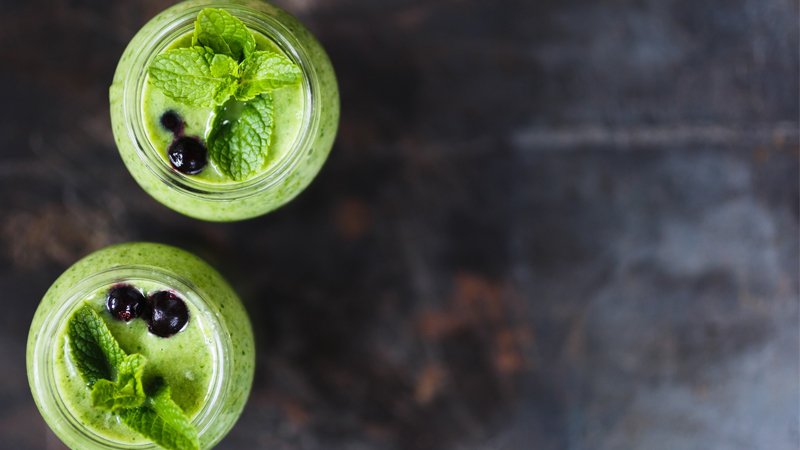
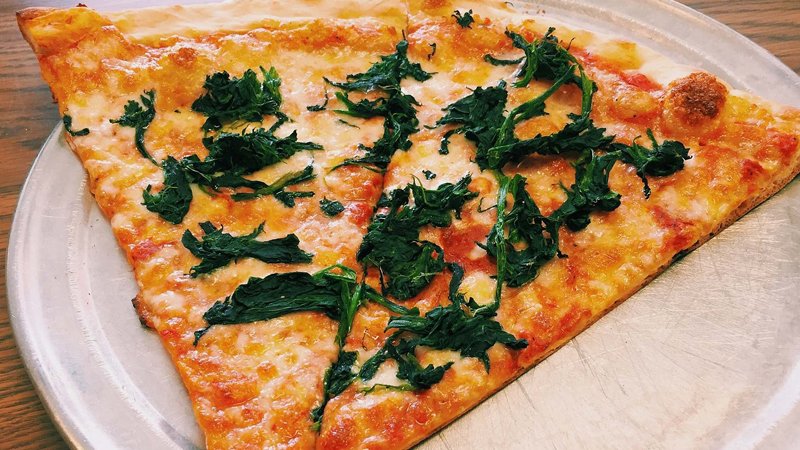
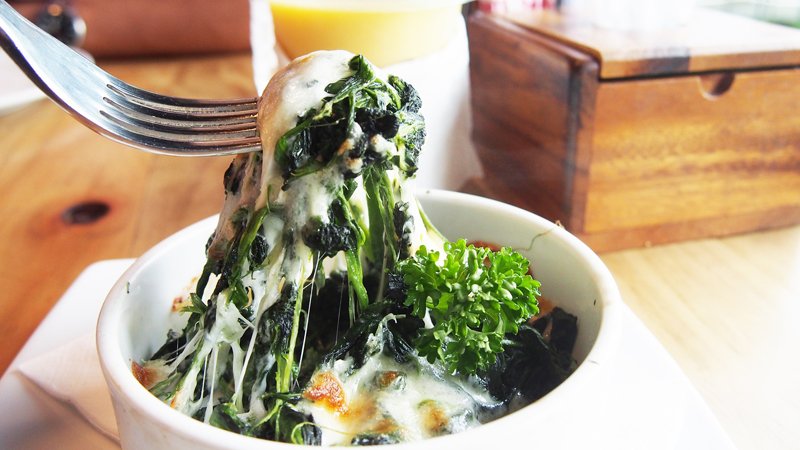
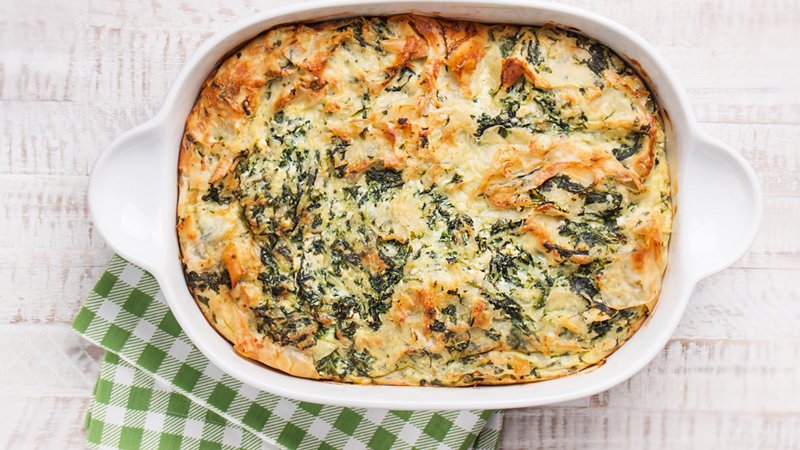
HOW TO MAKE SPINACH SALAD
No question, salads are the classic way to better include spinach in your daily diet. When it comes to spinach salad, there are a few questions to ask early on.
What type of other vegetables do I want in the salad?
Spinach goes well with a number of other colorful vegetables, or with other leafy greens like lettuce. Spinach does very well with bell peppers, tomatoes, red, yellow, or white onions, broccoli, cauliflower, and cucumber, but there’s no limit to what you can put into a spinach salad while preserving its deliciousness.
What type of dressing do I want on the salad?

OUR 5 BEST SPINACH SALAD RECIPES
Okay, so we know spinach is amazing, but let’s get more specific. How exactly should we work with it in the kitchen? What’s the plan? Here are some of our favorite spinach salad recipes. You’ll find that some of them provide raw spinach in its uncooked form, and others are for a semi-cooked, warm, or hot spinach salad, that brings out the health benefits of spinach that have been unlocked by the heat.
What About Baby Spinach Recipes?
Can’t forget the baby! Baby spinach is more delicate, and better for eating raw. We recommend using baby spinach for your raw spinach salads, and using mature more leafy spinach for your cooking. To give us some more spinach salad ideas, here is our list of our top 7 favorite spinach salad recipes.
1. Strawberry Spinach Salad
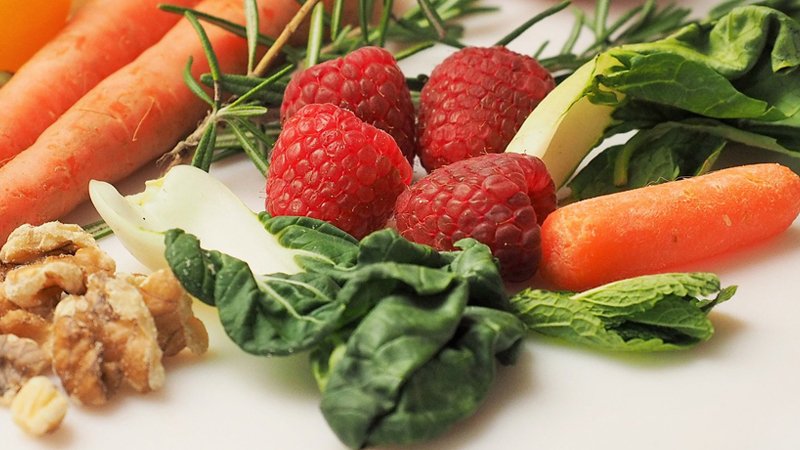
- 2 tablespoons sesame seeds
- 1 tablespoon poppy seeds
- ½ cup sugar
- ½ cup olive oil
- ¼ cup distilled white vinegar
- ¼ cup teaspoon paprika
- ¼ teaspoon Wocestershire sauce
- 1 tablespoon minced onion
- 10 ounces fresh spinach – rinsed, dried and torn into bite-size pieces
- 1 quart strawberries, cleaned, hulled and sliced
- ¼ cup of almonds, blanched and slivered
With one medium-sized mixing bowl, whisk sesame seeds in with poppy seeds, sugar, olive oil, vinegar, paprika, Worcestershire sauce and onion, covering and chilling in the refrigerator before serving. [source]
2. Spinach Cranberry Salad
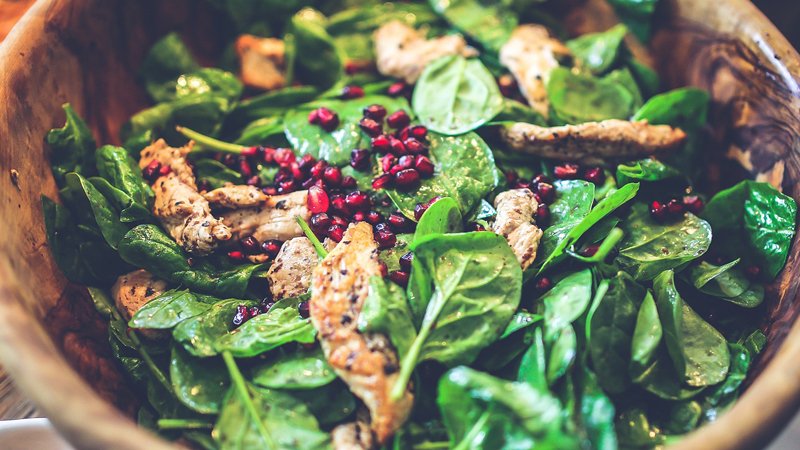
- ¼ cup white wine vinegar
- 2 Tbsp apple cider vinegar
- 3 Tbsp white sugar
- ½ cup olive oil
- 3 Tbsp honey
- 1 Tbsp finely minced shallot
- 2 Tbsp sesame seeds, toasted
- 1 Tbsp poppy seeds (your choice)
- 16 oz baby spinach
- 1 cup toasted almonds
- 1 cup dried cranberries
To make the dressing, mix the different vinegars with each other, and the sugar until it dissolves, then stir in the olive oil, honey, shallot, sesame seeds and optional poppy seeds, later adding the dressing to a freshly tossed salad bowl. [source]
3. Spinach Bacon Salad
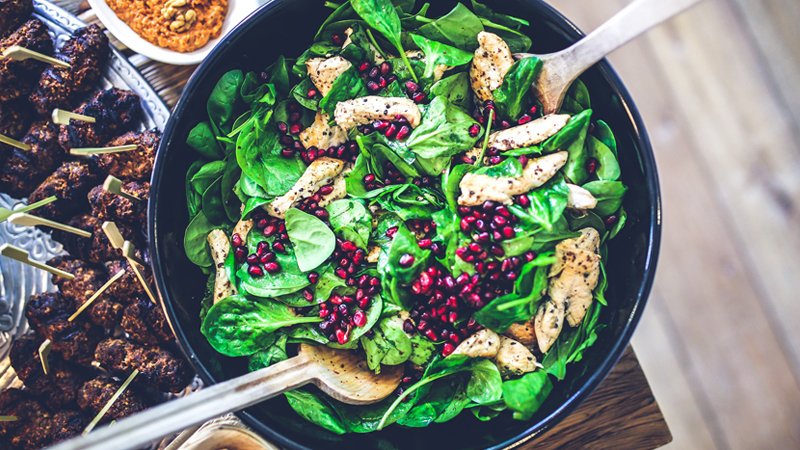
- 5 slices of bacon
- 1.5 Tbsp finely chopped shallot
- ½ cup red wine vinegar
- 2 Tbsp honey mustard (optionally using more to taste)
- Salt and fresh-ground pepper
- 8 cups of fresh spinach leaves, stems removed (we recommend baby spinach leaves)
- 8 ounces of white button mushrooms (or about 2.5 cups) thinly sliced
- ½ red onion, thinly sliced
Making for a hearty addition to any meal, this salad is a knockout for hungry folks. [source]
4. Garlic Sauteed Spinach
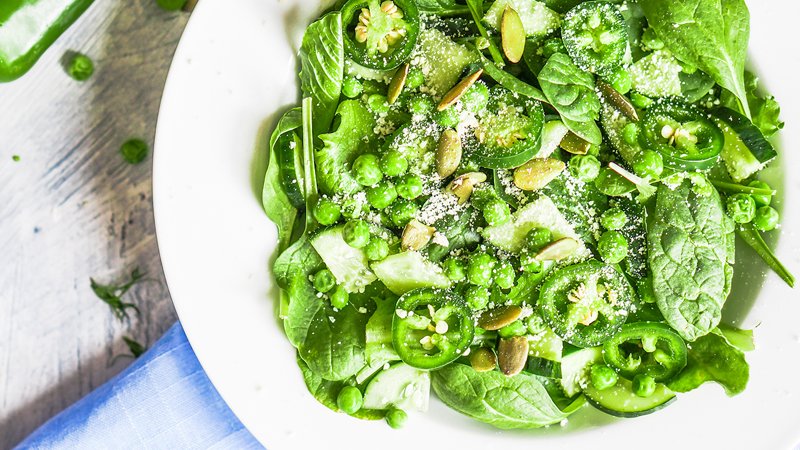
5. Sauteed Spinach With Soy And Sesame
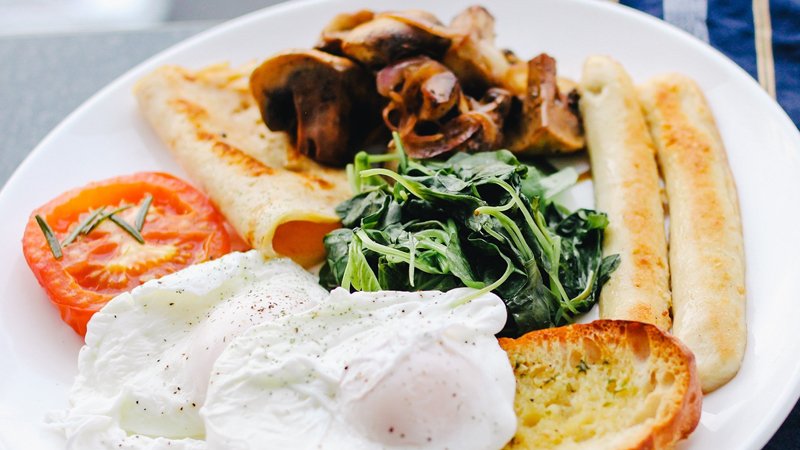
Easy Spinach Juice
Juicing spinach is easy. A few handfuls of spinach, variations of different fruits and vegetables and a citrus fruit (juiced in that order) and you have yourself a refreshing beverage filled with vitamins and enzymes. If you don’t have a juicer, you can start with the more affordable OMEGA J8006 Nutrition Center. This juicer has great reviews on Amazon and is perfect if you are just starting out with juicing and don’t mind cutting up your veggies a little bit before juicing. If you would like to invest a little more, you could try Breville 800JEXL Juicer, or the Omega VRT350 Juicer. The feed chutes are larger on these juicers, making it quicker and easier to make juice. Here is an easy spinach juice recipe you can try at home:
- A few handfuls of spinach
- A stalk of celery
- An apple
- Juice of half a lemon
Juice the ingredients together, starting with the spinach, then adding the celery and the apple. Stir in the juice of the lemon. Serve chilled or over ice. Store in the fridge. For optimal nutritional benefits, drink within 24 hours.
Conclusion:
In this article, we saw a background and introduction on spinach, 33 different distinct health benefits of spinach, five great spinach salad recipes, and how to minimize the risk posed by the oxalates in spinach. All told, there is no superfood quite like spinach. Among the greats, spinach just may be the greatest, healthiest food out there for human beings. Delicious and uniquely quite easy to eat in its raw state which allows for maximized nutrition, or cooked in the many, many possible ways of working with spinach in the kitchen- it’s hard to go wrong with spinach. Without a doubt, Popeye would be excited and feel at-home in today’s world of spinach savviness in the kitchen, and understanding of the health benefits of this miraculous superfood.

